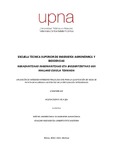Mostrar el registro sencillo del ítem
Aplicación de las imágenes hiperespectrales (HSI-NIR) para la clasificación de patatas de acuerdo a los efectos de la fertilización nitrogenada
| dc.creator | Zozaya Vela, Helena | es_ES |
| dc.date.accessioned | 2022-03-17T11:08:35Z | |
| dc.date.available | 2022-03-17T11:08:35Z | |
| dc.date.issued | 2022 | |
| dc.identifier.uri | https://hdl.handle.net/2454/42545 | |
| dc.description.abstract | En los últimos años, los niveles de CO2 en la atmósfera se han incrementado exponencialmente provocando un aumento de los estreses abióticos sobre los cultivos. Así, resulta fundamental emplear nuevas tecnologías que permitan identificar qué cultivares responden mejor frente a las consecuencias del cambio climático. Una de las técnicas más utilizadas en la actualidad son las imágenes hiperespectrales (HSI). Teniendo en cuenta la gran importancia mundial del cultivo de patata, en este estudio se han empleado HSI en el rango infrarrojo cercano con el objetivo de evaluar su potencial para identificar la respuesta, en hojas de patata, a la deficiencia de nitrógeno. Esto permitiría, desde el punto de vista económico, medioambiental y social, realizar una fertilización eficiente, acelerar el progreso en la mejora de cultivos y contribuir a la seguridad alimentaria. Se tomaron imágenes de 240 hojas de plantas de patata (6 variedades diferentes) sometidas a 2 clases de tratamientos de fertilización distintos. Mediante un análisis discriminante de mínimos cuadrados parciales (PLS-DA) se desarrolló un modelo capaz de clasificar correctamente en su clase el 53,06% de las muestras. Por su baja precisión, se concluyó que el empleo de HSI no fue efectivo para diferenciar las hojas sometidas a un déficit de nitrógeno de las cultivadas en condiciones óptimas. Tras contrastar los resultados con el método de referencia, se observó que todas las plantas respondieron igual, independientemente del tratamiento al que estuvieran sometidas. Así, realmente, las hojas de ambas clases no se diferenciaban químicamente y, por ende, se obtuvieron dichos resultados. | es_ES |
| dc.description.abstract | In recent years, CO2 levels in the atmosphere have increased exponentially, causing an increase in abiotic stresses on crops. Thus, it is essential to use emerging technologies to identify which cultivars respond better to the consequences of climate change. One of the most widely used techniques today is hyperspectral imaging (HSI). Taking into account the great global importance of potato cultivation, HSI in the near infrared range has been used in this study to evaluate its potential to identify the response of potato leaves to nitrogen deficiency. This would allow, from an economic, environmental and social point of view, an efficient fertilization, accelerating progress in breeding programs and contributing to food security. For this purpose, images were taken of 240 leaves of potato plants (6 different varieties) subjected to 2 different fertilization treatments. A partial least squares discriminant analysis (PLS-DA) was used to develop a model capable of correctly classifying 53.06% of the samples. Due to its low accuracy, it was concluded that the use of HSI was not effective in differentiating leaves subjected to nitrogen deficit from those grown under optimal conditions. After comparing the results with the reference method, it was observed that all plants responded the same, regardless of the treatment to which they were subjected. Thus, in fact, the leaves of the two classes did not differ chemically and, therefore, these results were obtained. | en |
| dc.format.mimetype | application/pdf | en |
| dc.language.iso | spa | en |
| dc.subject | Imágenes hiperespectrales | es_ES |
| dc.subject | Análisis PLS-DA | es_ES |
| dc.subject | Cambio climático | es_ES |
| dc.subject | Nitrógeno | es_ES |
| dc.subject | Patatas | es_ES |
| dc.subject | Hyperspectral imaging | en |
| dc.subject | PLS-DA analysis | en |
| dc.subject | Climate change | en |
| dc.subject | Nitrogen | en |
| dc.subject | Potatoes | en |
| dc.title | Aplicación de las imágenes hiperespectrales (HSI-NIR) para la clasificación de patatas de acuerdo a los efectos de la fertilización nitrogenada | es_ES |
| dc.type | Trabajo Fin de Máster/Master Amaierako Lana | es |
| dc.type | info:eu-repo/semantics/masterThesis | en |
| dc.date.updated | 2022-03-15T10:17:46Z | |
| dc.contributor.affiliation | Escuela Técnica Superior de Ingeniería Agronómica y Biociencias | es_ES |
| dc.contributor.affiliation | Nekazaritzako Ingeniaritzako eta Biozientzietako Goi Mailako Eskola Teknikoa | eu |
| dc.description.degree | Máster Universitario en Ingeniería Agronómica por la Universidad Pública de Navarra | es_ES |
| dc.description.degree | Nekazaritza Ingeniaritzako Unibertsitate Masterra Nafarroako Unibertsitate Publikoan | eu |
| dc.rights.accessRights | Acceso abierto / Sarbide irekia | es |
| dc.rights.accessRights | info:eu-repo/semantics/openAccess | en |
| dc.contributor.advisorTFE | Arazuri Garín, Silvia | es_ES |
| dc.contributor.advisorTFE | López Maestresalas, Ainara | es_ES |


